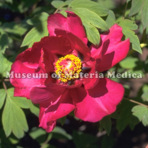Moutan Bark

|
Market name:大和丹皮 Photo location:Museum of Materia Medica, Inst. of Nat. Med. TMPW No.:17444 |

|
Plant name:Paeonia suffruticosa Photo location:Toyama Pref., Japan Photo date:1999 Photographer:K. Komatsu |
| Synonym | |
| Latin name | Moutan Cortex |
| Botanical source: Family name | Paeoniaceae |
| Botanical source: Plant name | Paeonia suffruticosa Andrews (IPNI:711877-1) |
| Part used | Root bak |
| Empirical criteria for quality selection | Good one has radial thickness without xylem. There are white powders on the cross section. It has strong aroma. (TN) |
| Constituents | Monoterpenoids: Paeoniflorin, Oxypaeoniflorin, Benzoylpaeoniflorin, Benzoyloxypaeoniflorin, Galloyl-paeoniflorin, Galloyl-oxypaeoniflorin Sterols: Campesterol, β-Sitosterol Tannins: Tetragalloylglucose, Pentagalloylglucose Other aromatic derivatives: Paeonol, Paeonolide, Paeonoside, Benzoic acid, Suffruticoside A, Suffruticoside B, Suffruticoside C, Suffruticoside D, Suffruticoside E |
| Pharmacological effects | Antiinflammatory (methanol extract), analgesic, antibacterial (E. coli, S. aureus), antiinflammatory, suppression of gastric juice secretion (paeonol). |
| Indications | As a tranquilizer, painkiller, for removing blood stasis and draining pus, it is applied to treat hematogenous disorder (blood circulation stasis) such as headache, abdominal pain, gynecologic disease, menstrual disorder and dysmenorrhea. |
| Diseases | Fever, Internal bleeding, Hematemesis, Nasal hemorrhage, Amenorrhea, Menorrhalgia, Intra-abdominal tumor, Swelling and pain due to contusion, Appendicitis, Pyogenic dermatosis, Headache, Red eye, Thirst, Irregular menstruation |
| Formulas | unkeito , kamikihito , kamishoyosan , kamishoyosankasenkyujio , kyukichoketsuin , kyukichoketsuindaiichikagen , keishibukuryogan , keishibukuryoganryokayokuinin , kojito , kogikujiogan , goshitsusan , goshajinkigan , seinetsuhoketsuto , sesshoin , daiobotampito , chibakujiogan , choyoto , toryuto , hachimijiogan , hachimisenkiho , mibakujiogan , rokumigan |
| Meridian tropism | Heart, Liver, Kidney |
| Property | Slightly cold |
| Flavor | Bitter, Acrid/pungent |
| Classification in "Shen-non Ben-cao Jing" | Middle |
| TCM: Classification | Antipyretics |
| TCM: Medicinal effects | To remove heat from blood, to activate blood circulation and eliminate blood stasis. Used for eruption in epidemic disease, spitting of blood, epistaxis, consumptive fever occurring at night and subsiding in the morning without sweating, amenorrhea dysmenorrhea, carbuncles and sores, traumatic injuries. |
| Remarks | Listed in the Japanese Pharmacopoeia 18th ed. |
| References | TN: T. Namba & Y. Tsuda ed., Outline of Pharmacognosy, a Textbook, 3rd ed., Nankodo Co., Ltd., Tokyo, 1998. |
DNA sequences of medicinal plants
| Gene Region | |||||||||||||||||||
| Nuclear | Chloroplast | Mitochondria | |||||||||||||||||
| Botanical source: Plant name | 5Ss | 18S | ITS1 | 5.8S | ITS2 | 26S | others | trnH-psbA | matK | trnK | trnK-rps16 | trnT-L | trnL | trnL-F | rbcL | rpoC1 | ndhF | others | |
|
|
|||||||||||||||||||
